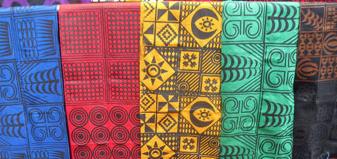Jan 25, 2016
Adinkra Colth
The Akan of Ghana have used cloth not only for personal adornment but also as a medium of communication. Adinkra cloth is one such cloth that encoded with visual symbols which represent popular proverbs or maxims, record historical events, and/or express particular attitudes or behaviours and have shared meanings in the society.
A view suggests that the art of weaving cloth and printing the adinkra cloth was known in Denkyira and other Akan areas even before the "Osa-nti" which occurred around 1700. This war ended the rule of the Denkyira over the Asante, and also gave rise to the Asante kingdom. The Asante, according to this explanation, learned the art of weaving and printing cloth from the Denkyira craftsmen and specialists who either defected or were captured during the war (Agyeman-Duah, n.d. no. 13). Wilks (1975, p. 456) writes: "The first and second Asokwahenes, Nuamoa and his full brother Akwadan, were among the many Denkyira who voluntarily transferred their allegiance to Osei Tutu in the late seventeenth century." When Akwadan defected he was said to have carried a trumpet that was made of gold. This must refer to a gilded abentia - gilded state horn (called nkrawoben).
These Denkyira people are said to have introduced several innovations not only in textile and other crafts but also in government and military organization. The Denkyira hypothesis is buttressed by the fact that a section of the Bonwire township is named Denkyira for the Denkyira people who either defected or were captured during the "Osa-nti" war. Oral history as told to me by several informants from Bonwire pointed out that the Denkyira crafts people were settled here and other parts of Kwabere to ply their trade.
If one accepted this hypothesis, then the 1818 Gyaman war must have resulted in bringing to Asokwa Gyaman war captives who might have introduced additional technological improvements (e.g., the use of carved apakyiwa in stamping (as compared to the use of feathers in the painting technique that Bowdich mentions in his 1819 book) in the textile industry. In the adinkra production process, Asokwa informants maintained that it was Nana Adinkra's son, Apau (or Apaa) who introduced innovations such as the use of calabash for carving out the stamps . He is also believed to have introduced the very first symbol (adwini kane), adinkrahene (king of the adinkra symbols). He is remembered and honored with the symbol Adinkraba Apau (Apau, Son of Adinkra). Other symbols are believed to have been copied from the carved column (sekyedua) of the stool and other regalia of Nana Adinkra of Gyaman (Kyerematen, 1964). This hypothesis is problematic because the Bowdich collection of 1817 has the adinkrahene symbol that is believed to have been introduced by Nana Adinkra's son.
Asokwa adinkra cloth producers are noted for designing and printing adinkra cloths for Asante royal houses, including Manhyia. The "Osa-nti" War which occurred around 1700 is believed to have brought Denkyira defectors or captives that included craftsmen and specialists that brought adinkra cloth printing to the Asantes (Agyeman-Duah, n.d. no. 13). Wilks (1975, p. 456) writes:
"The first and second Asokwahenes, Nuamoa and his full brother Akwadan, were among the many Denkyira who voluntarily transferred their allegiance to Osei Tutu in the late seventeenth century."
Click here to visit gallery

